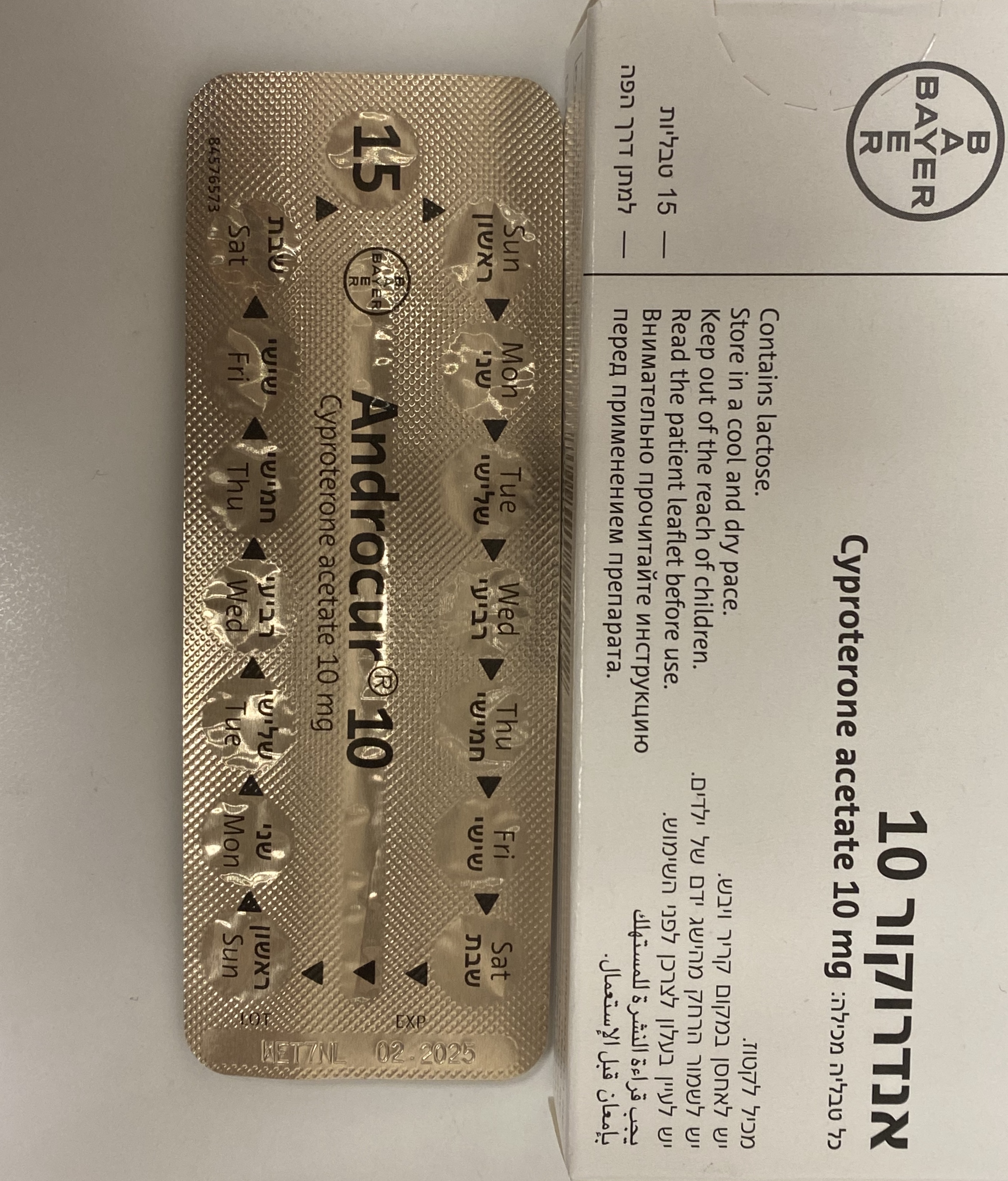Quest for the right Drug

אנדרוקור 10 ANDROCUR 10 (CYPROTERONE ACETATE)
תרופה במרשם
תרופה בסל
נרקוטיקה
ציטוטוקסיקה
צורת מתן:
פומי : PER OS
צורת מינון:
טבליה : TABLETS
עלון לרופא
מינוניםPosology התוויות
Indications תופעות לוואי
Adverse reactions התוויות נגד
Contraindications אינטראקציות
Interactions מינון יתר
Overdose הריון/הנקה
Pregnancy & Lactation אוכלוסיות מיוחדות
Special populations תכונות פרמקולוגיות
Pharmacological properties מידע רוקחי
Pharmaceutical particulars אזהרת שימוש
Special Warning עלון לרופא
Physicians Leaflet
Pharmacological properties : תכונות פרמקולוגיות
Pharmacodynamic Properties
5.1 Pharmacodynamic properties Pharmacotherapeutic group: Anti-androgen, pure ATC Code: G03 HA The anti-androgen properties of CPA, the active ingredient of Androcur 10 mg, permits specific therapy of androgenisation in women. Pathological, androgen-dependent conditions such as hirsutism, androgenetic alopecia and increased sebaceous-gland function, seen in acne and seborrhoea, are favourably influenced by competitive inhibition of androgens at the target organs. Remission occurs independently of whether increased androgen values or increased peripheral sensitivity cause the disorder. The reduction of the androgen concentration, which results from the antigonadotropic property of cyproterone acetate, has an additional therapeutic effect. CPA, which is also a potent progestogen, would result in reduced cycle control should it be administered continuously as a single drug. This can be diminished or avoided by combining it with an oestrogen or a suited progestogen-oestrogen product (oral contraceptive). Meningioma Based on a French epidemiological cohort study, a cumulative dose-dependent relationship was observed between cyproterone acetate and meningiomas. This study was based on data from the French health insurance (CNAM) and included a population of 253,777 women, who were taking tablets of 50-100 mg cyproterone acetate. The incidence of meningioma treated by surgery or radiation therapy was compared between women exposed to high-dose cyproterone acetate (cumulative dose ≥ 3 g) and women with only low exposure to cyproterone acetate (cumulative dose < 3 g). A correlation was revealed between the cumulative dose and occurrence. Cumulative dose of Incidence rate (in patient HRadj (95% CI)a cyproterone acetate years) Mild exposure (< 3 g) 4.5/100,000 Ref. Exposure up to ≥ 3 g 23.8/100,000 6.6 [4.0-11.1] 12 to 36 g 26/100,000 6.4 [3.6-11.5] 36 to 60 g 54.4/100,000 11.3 [5.8-22.2] more than 60 g 129.1/100,000 21.7 [10.8-43.5] *Adjusted according to age as a time-dependent variable and oestrogen at start of application A cumulative dose of, for example, 12 g may correspond to one year of treatment with 50 mg/day for 20 days per month.
Pharmacokinetic Properties
5.2 Pharmacokinetic properties Absorption CPA is completely absorbed in a wide dose range. The absolute bioavailability of CPA is 88 % of dose. Distribution Peak concentrations of approximately 75 ng/mL may be expected about 1.5 hours after oral ingestion of 10 mg CPA. Subsequently, the drug serum levels decrease biphasically, characterised by half-lives of about 0.8 hours and 2.3 days. The total clearance of CPA from serum is 3.6 mL/min/kg. CPA is present in serum almost exclusively in protein-bound form. About 3.5 – 4 % of total CPA levels are present unbound, and the remainder is bound to albumin. Since CPA binding to sex hormone binding globulin (SHBG) is not detectable, changes in sex hormone binding globulin (SHBG) levels do not affect the pharmacokinetics of CPA. Metabolisation CPA is metabolised by various pathways including hydroxylation and conjugation. The main metabolite in serum is 15β-hydroxy-CPA. Elimination Some CPA dose parts are excreted unchanged with the bile fluid. Most of the dose, however, is excreted in form of metabolites via urine and faeces at a ratio of 3:7 with a half- life of 1.9 days. Metabolites are eliminated from plasma at a similar rate (half-life of 1.7 days). Steady-state conditions That the active substance accumulates in serum by about the factor of 2 to 2.5 with daily administration within one treatment cycle is to be expected by virtue of the long terminal half-life of CPA. Smoking does not affect the pharmacokinetics of CPA.

שימוש לפי פנקס קופ''ח כללית 1994
Acne & hirsutism in females, hypersexuality in males
תאריך הכללה מקורי בסל
01/01/1995
הגבלות
תרופה שאושרה לשימוש כללי בקופ'ח
מידע נוסף
